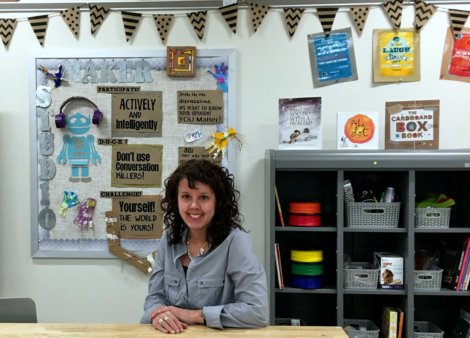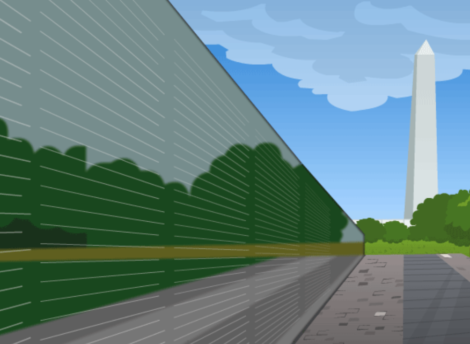
Differentiation with CBE of the Month Regina Schaffer
Posted by cemignano on
We’re thrilled to introduce you to May’s Certified BrainPOP Educator of the Month, Regina Schaffer! Regina was named one of NSBA’s “20 to Watch” for 2016 and we’re proud to call her a CBE. Read on to learn about Regina’s inspiring journey to becoming an educator and her experience as a CBE.
What grade(s) do you teach? Subject area?
I am an elementary instructional technology specialist at two different schools. I assist staff, students and parents in navigating the digital world.
How long have you been teaching?
This is my 20th year in education. I have taught several grades in elementary, as well as middle school English Language Arts and, most recently, History and Civics.
What inspired you to go into education?
Besides having teachers throughout my education that have inspired and believed in me, I have an aunt who lit my fire for teaching others. I would spend school breaks and some summers with her in Washington, DC and she would always take me to school with her. She had attended school during de-facto segregation in the capital and was inspired to stay after her Howard University graduation and make a difference. She taught high school English to students that other teachers would not. I would sit amazed, watching her guide students and those who “hated school” to love reading Moby Dick or Shakespeare, or other literature works, and inspire a true love of learning. She would connect literature to the complex lives of the students in her care as she taught them to use text and critical thinking to elevate themselves beyond their surroundings. The visual irony of seeing 6 foot+ boys hanging on the every word of this tiny, barely 5 foot tall woman, with the stereotypical English teacher glasses on the tip of her nose and hair in a neat tight bun, left me speechless. After every visit to Washington, I would return to NJ with stories of teaching and learning in the nation’s capital. My experiences with my aunt helped me determine early on that teaching was not only my calling but my passion, as I wanted to impact others and help students maintain the love of learning we all begin with in life.
Which CBE class were you a part of? What do you like about being a CBE?
I was part of the Philadelphia ISTE ‘15 class. I have used BrainPOP for at least the last 10 years of teaching History and Civics to 7th and 8th graders. I was the teacher that always volunteered to teach others how to use the latest resource that our school or district procured for us. Being a part of the CBE family has allowed me to connect, collaborate, and learn from (and with!) an incredible group of educators that are as passionate about using BrainPOP for engaging learning experiences as I am.
What is one of the most memorable projects you’ve done with your class using BrainPOP resources?
When I sat in the ISTE class and learned about Make-a-Map and Sortify with Andrew, I knew these would be learning resources that addressed learning style, depth, differentiation, creation, critical thinking, as well as higher level learning. Reading the research (Thank you, Scavenger Hunt!) supported my initial thoughts and cemented my resolve to use it with my 4th and 5th graders. While they have been using it across content areas all year, it was their recent Earth Day projects that proved to me how invaluable those tools had become in their learning and research. They used BrainPOP in their Earth Day inquiry project that charged them with answering the question, “How can students continue the work of early environmentalists to ensure their generation not only has clean air, water, etc; but leaves the earth in our local area in better shape than it is presently in?” They researched, took notes, collaborated with group members, and collated all of their findings from all sources, including BrainPOP, in their Make-a-Map notes space. They then created a plan of action, all the while using skills that we recognize students need to develop for the era they live in.
How has BrainPOP impacted a specific student (or group of students)?
Note-taking is skill that is challenging for some students to grasp, but introducing note-taking using Make-a-Map has virtually eliminated the stress and anxiety that documenting and summarizing research can bring. This year I used Make-a-Map to teach note-taking with the fourth grade, at one of my schools. Their initial ability to document information as they listened blossomed into understanding the connections that turned it into knowledge! Their academic confidence grew exponentially as they were able to use this skill across content areas as it assisted in their ability to research and organize information for essays and projects. Parents and teachers were impressed with the poise they exhibited while assisting younger students (Make-a-Map for BrainPOP Jr.!) who were learning to use this feature.
How has becoming a CBE impacted you?
Becoming a CBE has opened up another avenue to developing as an educator. Whether it is the security of knowing that I can jump into our G+ group and get assistance from my fellow CBEs or someone from BrainPOP, or connecting with local CBEs for training (district colleagues who are also CBEs), being part of the BrainPOP family has added to my evolution as a modern educator! Being a CBE and delving into all that BrainPOP has to offer has exposed me to research that is often missing with other educational technology products. We as educators are often times far removed from this aspect of academia, so reading the research that not only supports, but validates your approach to learning and pedagogy helps me endorse BrainPOP to those who still think it is only a video and quiz.
What are you most passionate about when it comes to education, technology, and your approaches to teaching?
I am passionate about creating authentic relevant learning experiences that bridge equity and opportunity gaps, and provide a foundation for students to become lifelong learners. Those are the common threads through everything I as a learner bring to students. I recently began learning to code again and, while I don’t think every student will become a programmer in the future (I am a lover of the arts, dance especially), I do think that the computational thinking skills it develops supports concepts across the curriculum. It’s the reason why I host an all girls coding/tech club using Google’s CS-First, Code.org, and, during the school day, we take advantage of the coding games BrainPOP provides.
With knowledge being free, technology can provide the bridge for underserved communities to become global citizens and create their own opportunities. Connecting communities with resources to provide that access is work that I will always be involved with, until we no longer need equity panels, summits or TED Talks to remind us of our responsibility to the next generation.
I am so excited about the shift that I see everyday in education as more and more teachers learn how to use technology to support current pedagogies. I love helping teachers on their journey as modern educators as we all (students, educators, parents) evolve as lifelong learners.
What’s on your BrainPOP wish list?
With most districts using GAFE or Office 365, and the current educational shift that is happening, digital collaboration has become part of the educational landscape that we are accustomed to and assume most products have or will develop. With that in mind, my BrainPOP wish is for collaboration features on Make-a-Map, Sortify, and all of the games. I know, I wish big, but I know the talented engineers creating for BrainPOP are probably already developing it!














